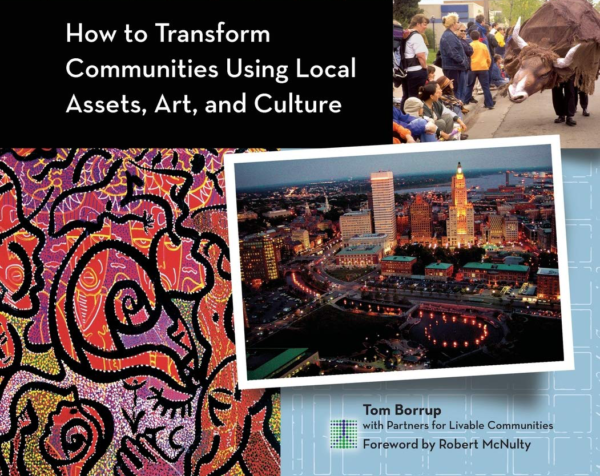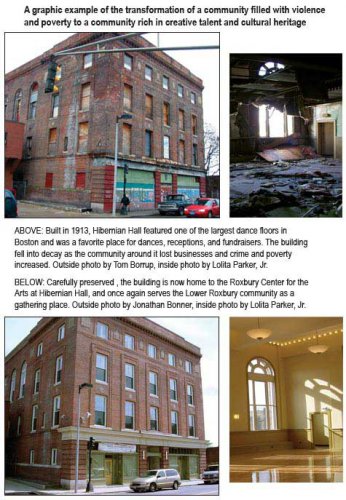Originally from the “Tools You Can Use” e-newsletter. Copyright Fieldstone Alliance (now Turner Publishing). All rights reserved.
WHAT MAKES A NEIGHBORHOOD, a town, or a city a great place to live and work?
Why do some communities consistently produce new ideas, engaged political life, deep networks of social activity, brisk commerce, vibrant cultural activities, and happy people?
How is it that a few people can push the right buttons and turn a dying village into a five-state cultural mecca?
What can we learn from the communities that have managed to create this kind of excitement and how can we do the same where we live and work?
Those questions are addressed in our newest book, The Creative Community Builder’s Handbook: How to Transform Communities Using Local Assets, Arts, and Culture. The book was funded by the McKnight Foundation, authored by Tom Borrup, principal of Community and Cultural Development, and published in collaboration with (and a foreword from) Partners for Livable Communities.
In this issue of Tools You Can Use, I list the book’s ten economic and social capital development strategies and highlight one example of how a strategy played out. I hope this is enough to get you started thinking about ways you can help strengthen your community.
Ten Strategies for Building on a Community’s Unique Qualities
Author Tom Borrup describes ten economic and social capital development strategies. For each of the ten strategies, two case studies are offered from dissimilar rural, urban, and suburban communities across the United States. They are old and new, rich and poor, dominated by one ethnic population and culturally very mixed. They also represent projects of differing scales relative to their communities
It’s artificial to view these projects as impacting their communities in only economic terms or social terms. All of them contribute to their communities in more holistic ways, building both economic and social capital. For illustration purposes however, the author focuses on one key area of impact per example.
These examples are not offered as models to be replicated—quite the opposite. Each evolved in its unique setting, led by visionary individuals, and each employed indigenous assets in response to local challenges. An important point in this book is that each creative community builder and each place should employ approaches that fit the community’s capacity, size, and needs.
The list below, from page nineteen of the book, shows the ten economic and social development strategies and the case studies that illustrate each strategy.
Economic development strategies
1. Create Jobs
Nurture artists and small cultural organizations as businesses and microenterprises to increase employment
- Penn Avenue Arts Initiative, Pittsburgh, PA
- San José Arts Incubator, San José, CA
2. Stimulate Trade through Cultural Tourism
Create the right conditions for, and engage in, cultural tourism to bring new resources to the community
- Pilsen/Little Village Information Center, Chicago, IL
- Lanesboro Art Council, Town of Lanesboro, MN
3. Attract Investment by Creating Live/Work Zones for Artists
Support artists and artist live/work spaces as anchors around which to build local economies
- Artist Loft Program and Arts District, Department of Planning and Development, City of Peekskill, NY
- Torpedo Factory Artists’ Association, Alexandria, VA
4. Diversify the Local Economy
Cluster arts organizations as retail anchors and activity generators to attract and support other enterprises
- ACT Roxbury and Madison Park Development Corporation, Boston, MA
- Massachusetts Museum of Contemporary Art, North Adams, MA
5. Improve Property and Enhance Value
Leverage the proximity of cultural amenities and the artists’ touch to improve property and increase its value
- West End/Clingman Revitalization, Asheville, NC
- Paducah Artist Relocation Program, Paducah, KY
Social development strategies
6. Promote Interaction in Public Space
Engage people in public spaces through public art and collective cultural experience
- WaterFire Providence, Providence, RI
- Voice of the River Project and Leo Adler Memorial Parkway, Baker City, Oregon
7. Increase Civic Participation through Cultural Celebrations
Strengthen connections between neighbors through cultural celebrations and festivals
- May Day Parade and Festival, Minneapolis, MN
- Delray Beach Cultural Loop, City of Delray Beach, FL
8. Engage Youth
Include young people in civic affairs and enterprises through meaningful work and activity
- Artists for Humanity, Boston, MA
- Youth Radio, Berkeley, CA
9. Promote Stewardship of Place
Develop civic pride and responsibility through good “place making” and design practices
- Hope Community, Minneapolis, MN
- Southgate Linear Park, City of Tamarac, FL
10. Broaden Participation in the Civic Agenda
Expand involvement in civic issues and governance through community-centered arts and cultural practices
- Danville Transportation Enhancement Project, Danville, VT
- Understanding Neighbors, Anchorage, AK
An Example of One Strategy and Its Dramatic Impact
Let’s take a look at an example of strategy #2 (Stimulate Trade through Cultural Tourism) and its impact on Lanesboro, Minnesota.
Seven five-star chefs, a full-time theater, and a population of 800
In the mid-1980s, the rural town of Lanesboro, Minnesota, was dying. Thirty-eight of the forty available downtown storefronts were vacant.
Two decades later, only two storefronts are vacant. There’s a full-time staffed theater with an eleven-month season that draws guests from five states. Visitors flock for biking, canoeing, trout angling, golfing, gallery visits, fine cuisine, and some of the best bed and breakfasts you’ll find.
Lanesboro is one of a number of communities that have capitalized on local talent to attract more talent and tourists—to turn the economy around using cultural tourism to stimulate trade. It started with some native assets:
- Visionary local leaders
- Residents who shared a love of the town and a tradition of hospitality and entrepreneurship
- A historic, if empty, downtown whose buildings were unblemished and unremodeled
- A lovely setting along the bluffs of an icy trout stream
- The Lanesboro Art Council, a local arts organization founded in 1981
- A commitment to maintaining historic charm and natural beauty
- The opening of a state bicycle trail
How it happened
In the early 1980s, a state decision to transform an abandoned rail line to a bicycling and walking trail triggered the town’s revival. The gorgeous bluff-country ride became an immediate draw. A bed and breakfast that featured a five-star chef soon followed.
As more B & B’s opened, the Lanesboro Art Council bought an abandoned downtown theater for $5,000 and began to produce voluntary community events. Bicycle tourism increased, and the Art Council decided to lure an expatriate home to start a theater company.
Other arts groups sprang up, and a small but energetic group helped attract more talent and excitement. The nonprofit Cornucopia Art Center opened in 1994 on the town’s main street, with a mission to be a catalyst for artistic and educational development in southeastern Minnesota and the Upper Midwest. Exhibits and gallery sales of regional artists were added. Through its national artists in residence program, four to six artists each year were brought in to engage the community in creative activities.
By 2000, Lanesboro’s leaders had arrived at a strategy and brand identity for the town that blended its exquisite natural setting with hospitality and the arts—offering big city amenities in a small town environment. They began advertising to increase cultural tourism and build more business.
By 2004, the town of under 800 people had seven resident five-star chefs, making it a destination for fine dining as well as arts, relaxation, and outdoor fun. A music festival, summer concerts, farmers market, and art-in-the-park were added. Town leaders brought in high-speed Internet and began advertising for artists, performers, and creative entrepreneurs of all sorts.
The strategies could be summed as:
- Reinforce and validate the community identity
- Advertise community assets to increase tourism
- Cultivate a growing artistic community
- Actively recruit a creative workforce
The outcomes are significant. Tourism trade has increased dramatically. Most of the main street buildings have been restored and reoccupied. The theater and art center have been expanded. Real estate and business investment has increased. Area artists generate $12,000 a month in art sales. Tourist beds have increased ninefold in fifteen years. A new $3.5 million facility is in planning for the theater. Outside magazine featured Lanesboro as one of the 20 Best Dream Towns in America to live and play. And the list goes on.
Work with what you’ve got
Lanesboro is inspiring. The success they earned was not through attracting some big group to come in and build a retail store, establish a factory, or open a government center. They took a hard look at what they had and saw diamonds where others saw dust. They worked with local talent, local connections, the natural and built environment, and massive amounts of creativity. As their successes grew, their vision became bolder rather than more protective.
The good news is that Lanesboro is not an isolated example. There are nineteen more inspiring examples in the book, and hundreds across the country. The mix of human, natural, and economic assets in any one locale will always differ dramatically, but they are there and they will respond when people gather to act on them.






